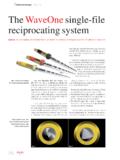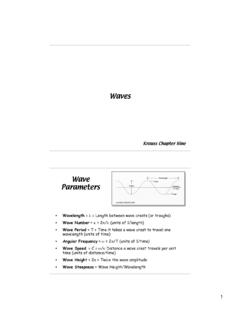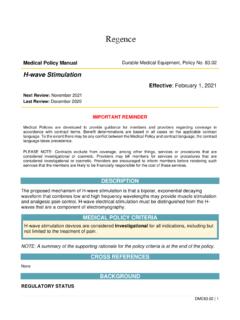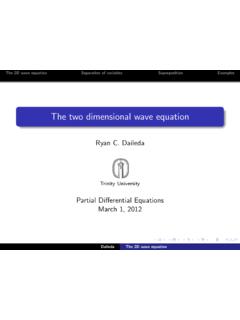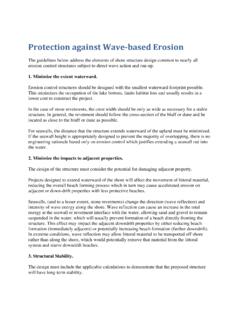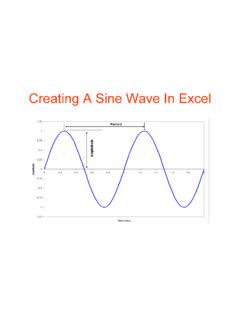Transcription of Chapter 5 Lecture: Wave Setup and Setdown
1 Chapter 5 lecture : Wave Setup and SetdownRadiation stresses can be applied in many cases where surface gravity waves generate flows ontime- and length-scales longer than waves . This is particularly true when there are spatial gradientsin the average wave properties ( ,wave energyE), such as what happends when waves shoal,refract, encounter a current, and we shall consider the simplest such applications, but an extremely important one of whathappens when waves shoal as the water depth decreases, and briefly what happens when wavesbegin to break. Other, more complex applications will be addressed DerivationConsider the case of no mean flow, waves approaching the shore with bottom slopedh/dx[FIG-URE] To analyze what happends in this situation we consider1.
2 The wave induced momentum fluxSxxacross two vertical planes separated bydxsuch thatthe change in momentum flux The response of the depth-integrated mean pressure p= g( z)to this change now allow here the mean surface to variable so that the surface can adjust to the wavefield. This term is vertically integrated to h p xdz= g h ( z) xdz= g( +h) x.( )Conservation ofx-momentum then implies that g( +h)d dx+dSxxdx=0,( )24where note that this is a non-linear 1st order ordinary differential equation for the mean sea-surface . This equation can no be used to derive wave-induced Setdown and Setup which are the depres-sion of the sea-surface during shoaling and the elevation of the sea-surface during wave this ODE ( ) is simplified by assuming that hyieldingd dx= 1 ghdSxxdx.
3 ( )In order to solve the ODE for , one only needs to specify the wave field to estimateSxxandspecify a boundary condition for . Here, we will consider two regions1. Shoaling, with conserved wave energy fluxEcg, which leads to Surfzone wave breaking which leads to Wave-induced set-downThere are many examples of solutions to the wave set-down problem and in particular the originalsolution given by Longuet-Higgins and Stewart (1962) is most elegant yet complex. Here, weshall consider the far simpler problem of thelinearset-down problem in shallow water whereSxx=3 in this case the local wave energyE=E0cg0cg=12 ga20 h0h 1/2.
4 ( )where variables with subscript 0 indicate that they are at the location where the boundary condi-tion comes in. Now the cross-shore momentum equationd dx= 1 ghdSxxdx= 3a20h1/2041hd h 1/2 dx( )=3a20h1/20412h 5/2dhdx= a20h1/202d h 3/2 dx.( )This equation can be integrated from offshorex0to onshore atx, xx0d dx dx = (x) 0= 12a20h1/20 h 3/2 h 3/20 .( )At this point we can redefine the sea-surface atx0to be zero, , 0=0. Now ifh<h0, thisimplies that h 3/2 h 3/20 >0which implies that (x)= 12a20h1/20 h 3/2 h 3/20 .( )25is negative for shoaling that this solution is relatively limited to shallow water situations. The beautiful and com-plex solutions for valid for anykhgiven in Longuet-Higgins and Stewart (1962) but the primarypoint is made here.
5 For shoaling waves , as the wave amplitude (or height) increases, the sea surfaceis SurfzoneIn order to describe the state of the sea-surface elevation inside the surfzone where waves arebreaking, one has to first describe the waves . We will examine this in detail later, but for now letus assume heuristically that =H/his a known constant applicable inside the surfzone. Thisimplies thata= h/2and plugging intoSxx=3E/2results inSxx=316 g 2h2.( )Using this and plugging into the linear Setup equation ( ) one getsd dx= 38 2dhdx.( )Now if the beach slopedh/dxis monotonic and decreases farther onshore thendh/dxis negativeand sod /dxis positive, that is the sea surface tilts up.
6 Note that this can be integrated from thebreakpointxbonshore and for a planar beach = 38 2 h.( )where h=h hb. As his negative, this implies that is recall that this form for the wave-induced set-up assumes h. This will clearly notbe true near the shoreline where the still water depth goes to zero. The set-up problem can also beexamined with the full non-linear relationship ( ), rewritten asd dx= 1 g( +h)dSxxdx,( )and instead of ( ), we writeSxx=316 g 2( +h)2. With this we can writed dx= 38 2 d dx+dhdx ( )d dx= 38 2 1+38 2 1dhdx( )d dx=Kdhdx( )26 WAVE 'SET-DOWN' AND SET-UP 2573 MEAN WATER LEVEL, 'l1 o o o THEORY o o 20 7 eml.
7 10 05 0;6 W L-. ____ O_--t-------o BJEJ 05 POINT 1 PLUNGE x x x x x lpOINT BEACH WAVE CREST x x x x x x .. ENVELOPE OF WAVE HEIGHT 6 x' 4 2 }ems. S. WL. o -2 --4-400 300 200 o DISTANCE FROM STILL WATER BEACH, x (ems) Fig. 2. Profile of the mean water level and the envelope of the wave height for a typical experiment. Theoretical plot is from equation 7. Wave period, sec; Ho = cm; Hb = cm; tan fJ = As might be expected from (7), the difference between the observed and the theoretical 'set-down' is well correlated with the difference be-tween the observed wave height and the wave height predicted by first-order theory.
8 Close to the break point the 'set-down' must be influenced by the fact that the solutions inside and outside the breakers must be patched together in a reasonable way. Experimentally, it was found that the 'set-down' was rather con-stant between the point where the crest of the wave begins to curl over and the point where the whole wave form collapses. These two points are defined as the break point and the plunge point (Figure 2). Inshore from the plunge point a region of rebound was observed where the broken wave reformed and then moved up the beach as a regular bore. The rebound was asso-ciated with a rather rapid rise in the mean water level.
9 Further inshore, where the bore was well formed, the set-up increased steadily, the gradient of the set-up being approximately constant as the theoretical results suggest. The measurements showed that in this region the wave height tends to be a linear function of the mean water depth, Figure : Profile of mean water level and the envelope of wave height for a typical experimentwithH0= ,T= , and beach slope = (from Bowen et al., 1968).whereK=(1+3 2/8) 1( )Thus the effect on including the full nonlinear depth is to reduce the set-up. This can already beseen from ( ) that within the surfzone( +h)>hand so the Setup slope will be BOWEN, INMAN, AND SIMMONS 20 if) E u :r: 10 o EXPERIMENT 71/4 'i( '/5 A 35'12 10 20 \7j+hl ems 30 Fig.
10 3. Wave height inside the break point, near maximum set-up, as a function of the mean depth, showing linearity of the relation and the residual wave height at ij + h = o. ii + h (Figure 3) as is assumed in equation 11. There was, however, always some residual wave height Hr at the beach, indicating that equation 10 should read H = Hr + ,,/(ii + h). Then equation 12 becomes dii = -leii + h) + "/Hr dh dx -(R/3 + ,,/2)(ii + h) + "/H: dx so that, as ii + h 0, diildx -dhldx. This suggests that very close to the shore the set-up should steepen, becoming tangential to the beach as ii + h o. Perhaps surprisingly, this tendency can be seen quite clearly in several of the experiments (Figure 4).
